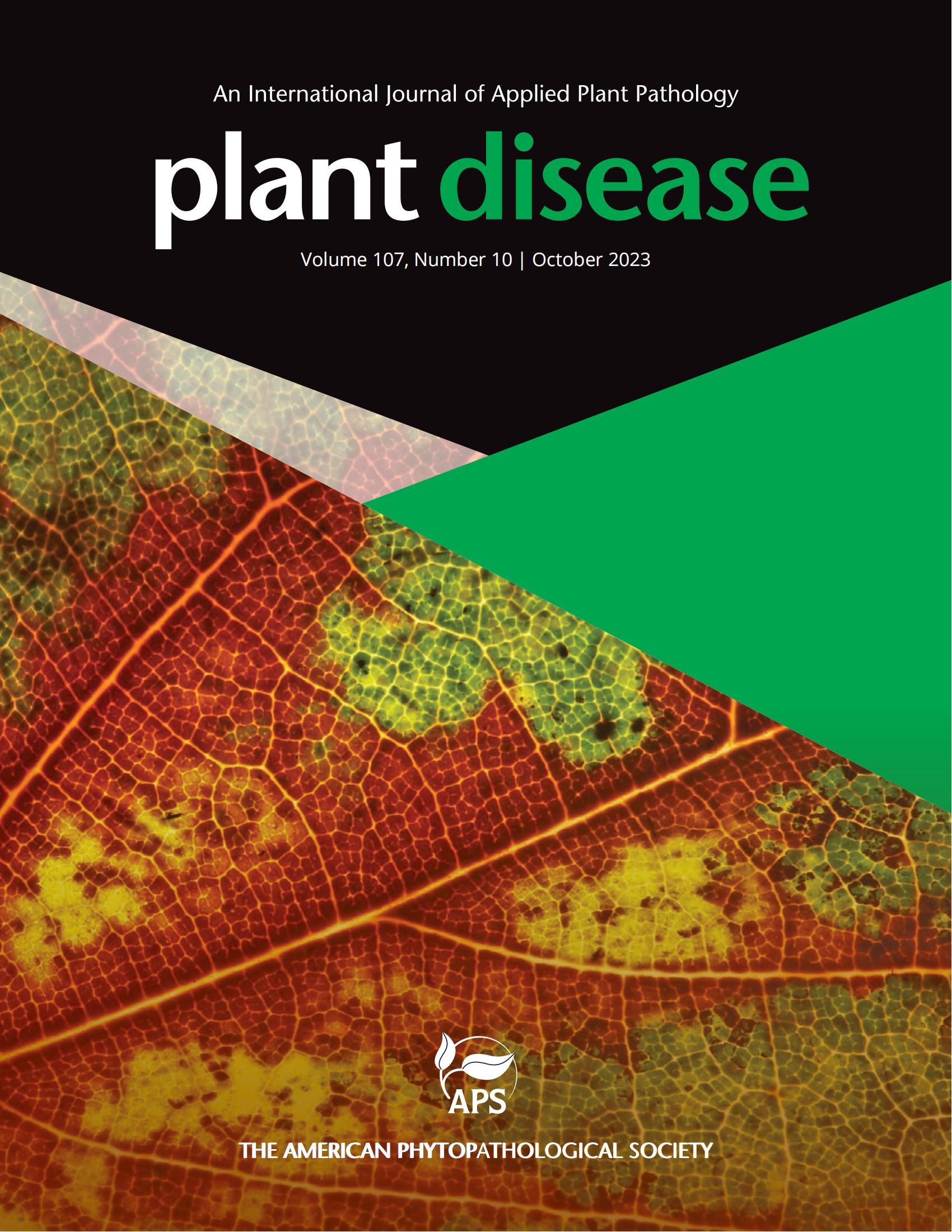新拟盘多毛孢在中国引起飞天花叶斑病的首次报道。
摘要
附属物是中国一种具有重要药用和观赏价值的草本植物。2024年5月,在云南省昆明云南中医药大学药用植物育苗基地(24°33′59.21”N, 99°55′43.71”E)发现附属物叶斑病,发病率为75%。有症状的叶片沿边缘呈不规则的棕色病变,周围有黄色晕。为了确定致病因子,取有症状的叶片组织(5 × 5 mm), 75%乙醇表面消毒30 s,然后用1%次氯酸钠(NaClO)浸泡180 s,用无菌蒸馏水冲洗3次。将无菌组织转移到马铃薯葡萄糖琼脂(PDA)上,在28°C的黑暗环境下培养3 d。采用单孢子纯化法获得纯培养物。共分离得到5株单孢子菌株。分离株表现出白色、棉质气生菌丝,菌落边缘呈波浪形。分生孢子梭形,四隔,中间细胞为3个花斑色,顶细胞和基细胞呈透明状(长17.3 ~ 26.8µm,宽3.7 ~ 6.2µm);N = 30)。顶端细胞有2 ~ 3个附属物(19.6 ~ 28)。6 μm长;N = 30),而基底细胞只有一个未分枝的附属物。为了进一步鉴定真菌,随机选取SeF01分离物进行测序。分别利用引物对ITS1/ITS4 (White et al., 1990)、LR0R/LR5 (Schoch et al., 2012)、T1/T2 (O'Donnell and Cigelnik, 1997)和EF1-728F/EF1-986R (Carbone and Kohn, 1999)对核糖体内转录间隔段(ITS)、大亚基核糖体RNA基因(LSU)、β-微管蛋白基因(TUB2)和翻译伸长因子-1α (TEF-1α)区域进行扩增和测序。BLASTn同源性分析显示ITS (GenBank登录号:分离物SeF01的PV363391、LSU (PV363539)、TUB2 (PV384116)和TEF-1α (PV384117)序列与新拟绿多opsis rosae菌株CBS 101057 (KM199359、KM116245、KM199429和KM199523)的同源性为99.44 ~ 100%。基于ITS、LSU、TUB2和TEF-1α的核苷酸序列,采用极大似然法构建了新拟多毛藓种的系统发育树。SeF01与N. rosae在同一枝上分离。形态学和分子分析证实SeF01与玫瑰孢粉相同。采用1 × 106分生孢子/mL的分生孢子悬浮液喷洒在附生草植株上直至径流,对照植株用无菌蒸馏水喷洒,以确定菌株的致病性。进行2个重复(6株/重复)。所有植株在28℃、80%相对湿度条件下培养,光照12 h /黑暗12 h。15 d后,接种植株出现叶斑病症状,而对照植株无症状。从有症状的叶片中重新分离的真菌菌株显示出与SeF01相同的形态特征。据报道,玫瑰螨可引起花椒、石榴和金银花的叶斑病。据我们所知,这是中国首次报道由玫瑰粉蚧引起的叶斑病。该病显著降低了猪链球菌的价值,建议采取病原体特异性控制措施。Stephania epigaea Lo is an herb of significant medicinal and ornamental value in China. In May 2024, leaf spot disease was observed on S. epigaea in the medicinal plant nursery base of Yunnan University of Chinese Medicine, Kunming, Yunnan Province, China (24°33'59.21"N, 99°55'43.71"E), with an incidence rate of 75%. The symptomatic leaves exhibited irregular brown lesions along the margins, surrounded by a yellow halo. To determine the causal agents, symptomatic leaf tissues (5 × 5 mm) were excised, surface-sterilized in 75% ethanol for 30 s, followed by immersion in 1% sodium hypochlorite (NaClO) for 180 s, and rinsed three times with sterile distilled water. The sterilized tissues were transferred onto potato dextrose agar (PDA) and incubated at 28°C in the dark for 3 d. Pure cultures were obtained using the single-spore purification method. A total of five single-spore isolates were obtained. The isolates exhibited white, cottony aerial mycelia with undulated colony margins. Conidia were fusiform and four-septate, with three versicolor median cells and hyaline apical and basal cells (17.3-26.8 µm long × 3.7-6.2 µm wide; n = 30). The apical cells bore two to three appendages (19.6-28. 6 μm long; n = 30), while the basal cells bore a single unbranched appendage. To further identify the fungus, isolate SeF01 was randomly selected for sequencing. The nuclear ribosomal internal transcribed spacers (ITS), large subunit ribosomal RNA gene (LSU), β-tubulin gene (TUB2), and translation elongation factor-1α (TEF-1α) regions were amplified and sequenced using primer pairs ITS1/ITS4 (White et al., 1990), LR0R/LR5 (Schoch et al., 2012), T1/T2 (O'Donnell and Cigelnik, 1997), and EF1-728F/EF1-986R (Carbone and Kohn, 1999), respectively. BLASTn homology analysis revealed that the ITS (GenBank accession no. PV363391), LSU (PV363539), TUB2 (PV384116), and TEF-1α (PV384117) sequences of isolate SeF01 exhibited 99.44-100% identity with Neopestalotiopsis rosae strain CBS 101057 (KM199359, KM116245, KM199429, and KM199523). A phylogenetic tree of Neopestalotiopsis species was built based on concatenated nucleotide sequences of ITS, LSU, TUB2, and TEF-1α using the maximum likelihood method. Isolate SeF01 clustered with N. rosae on the same branch. Morphological and molecular analyses confirmed that SeF01 was identical to N. rosae. To confirm pathogenicity of the isolate, conidial suspension with 1 × 106 conidia/mL was sprayed onto S. epigaea plants until runoff, while the control plants were sprayed with sterile distilled water. Two replicates (6 plants/replicates) were performed. All plants were incubated at 28℃ and 80% relative humidity with a 12 h light/12 h dark photoperiod. After 15 d, inoculated plants developed leaf spot symptoms, whereas control plants remained symptom-free. Fungal strains re-isolated from symptomatic leaves displayed morphological characteristics identical to SeF01. N. rosae has been reported to cause leaf spot on Fragaria × ananassa, Punica granatum, and Lonicera caerulea. To our knowledge, this is the first report of leaf spot caused by N. rosae on S. epigaea in China. The disease significantly reduces the value of S. epigaea, and pathogen-specific control measures are recommended.

 求助内容:
求助内容: 应助结果提醒方式:
应助结果提醒方式:


